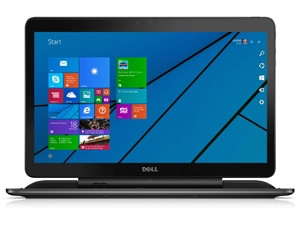
Convertibles, smart combinations of a tablet and notebook, are steadily gaining the interest of both home and business users. While Dell facilitated typical consumers with the XPS 12 and the Venue tablets, business users were left in the cold. Good thing Dell recently launched the new Latitude 7350, a 13.3-inch Windows dedicated business convertible. Is it any good at the office, and how does it measure up to similar devices?
In order to answer these questions, we got to work with the Latitude 7350 for a week and deployed it for all our business-related tasks like communicating, handling documents and browsing the Internet. During that week, we also ran various performance benchmarks on the device, tested the stamina of the battery and measured the quality of the screen with dedicated equipment. Although Dell offers more than just one configuration of the Latitude 7350, our review model was fitted with an Intel Core M-5Y10 CPU, 4GB RAM and a 128GB SSD. Models with deviating specifications may produce slightly different test results.
Look and feel: dual battery design
The Dell Latitude 7350 convertible consists of two components, the keyboard (dock) and the tablet, effectively the screen. Both are manufactured from durable, black metal that helps give the Latitude 7350 a premium look and feel. The tablet is relatively big as a result of the 13.3-inch screen. It weighs 922g, which is a lot more than your average tablet.
All the important hardware the Latitude 7350 needs, like the processors and RAM, is located right behind the screen. This means the tablet is a fully-functional device that can be used completely autonomous from the keyboard. Some convertibles are prone to easily tipping over because the tablet outweighs the keyboard. Because the Latitude 7350 houses a secondary battery inside the keyboard, which acts as a counterweight, that's unlikely to happen with this device.

In order to disconnect the tablet, you just need to flip a little slider positioned near the hinge of the keyboard. The whole construction feels very solid and will definitely have no trouble lasting through rough days at the office or demanding business trips. Because all the internal hardware, except the secondary battery, is located in the tablet, there is enough space left to facilitate a very comfortable touchpad and keyboard. As a result, working on long documents for hours and hours will prove no problem. To top it all off, the keyboard features a backlight so you can continue to work even when it's completely dark, like during an overseas night-flight.
What typically differentiates a business notebook from a consumer version, apart from the lack of frills and often a better build quality, are hardware security options. When purchasing the Dell Latitude 7350 you can optionally choose to have an integrated smartcard- and fingerprint reader installed. This way, the Latitude 7350 can meet any corporate security policy that requires these measures to protect sensitive data or general access to the office network.
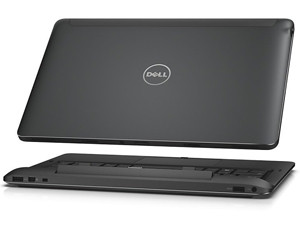
The Latitude 7350 doesn't offer many physical connection options. There's no USB connector on the tablet, but two can be found on the back of the keyboard. Both support usb-3.0, while only one can be used to charge other devices, even when the Latitude 7350 is turned off. Although there is a mini display port connector to hook the Latitude 7350 up to an external screen, it surprisingly lacks an Ethernet port. This might be a problem for business users whose corporate security policy enforces them to only use a wired connection to access the office network. The only solution is to purchase an optional USB-to-Ethernet adapter, but then again that will only leave you with one free USB connector.
Hardware, benchmarks: built for the office
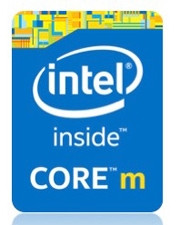
Dell equipped the Latitude 7350 convertible with Intel's Core M-5Y10 (dual-core) chip that runs on a base frequency of 800MHz per core and can briefly turbo-charge to 2GHz when needed. The device also houses 4GB of RAM on board, which is the absolute minimum for the pre-installed Windows 8.1 Pro to comfortably do its job. To handle graphics, the Latitude 7350 is fitted with a fairly standard Intel HD 5300 video chip.
To accurately measure how all the internal hardware performs, we ran three separate benchmark tests. The Latitude 735's test results were then compared to those of similar devices.
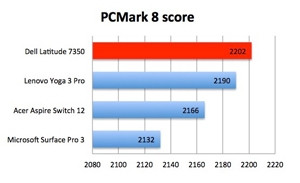
We started our performance tests with PCMark 8, which is considered an industry-standard benchmark tool for the Windows platform. PCMark 8 accurately measures performance using real-world tasks and applications that reflect typical office use. It showed us the Dell Latitude 7350 marginally outperforms the Lenovo Yoga 3 Pro, Acer Aspire Switch 12 and Microsoft's Surface Pro 3.
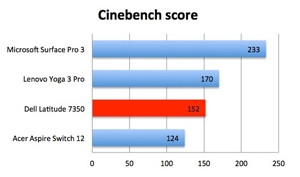
According to Cinebench, a program that primarily measures the maximum performance of the CPU and GPU during heavy workloads, the Latitude 7350 is not the best convertible for this job. Microsoft's Surface Pro 3 clearly handles processor-intensive tasks better than the other devices.
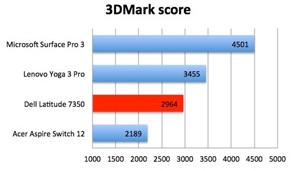
To see how the Dell Latitude 7350 handles complex graphics, we used 3DMark. Not only does this program focus on heavy workload and processing intensive tasks, it specifically measures complex 3D-graphics performance. 3DMark was able to confirm Cinebench's results, from a relative point of view the Latitude 7350 can't impress while the Surface Pro 3 seems to be the best convertible for heavier tasks.
In absolute terms, the processing power of the Dell Latitude 7350 proves more than sufficient for typical business activities, as PCMark 8 made clear. It does, however, fall short when deployed for heavier tasks like semi-professional video and photo editing.
Battery life: tops all convertibles
From years of experience, designers at Dell realised long battery life is a key consideration for most business users. As a result, the Dell Latitude 7350 is equipped with two separate batteries. It houses a 30Wh capacity version in the tablet and another 20Wh underneath the keyboard, making 50Wh in total. The three other convertibles featured a 36Wh (Aspire Switch 12), 42Wh (Surface Pro 3) and 44Wh (Yoga 3 Pro) battery.
Our first battery test simulates typical office activities like communicating, browsing and editing documents. The second test continuously plays a 1 080p movie until there is no energy left. Both torture-tests aim to drain the battery as fast as possible, effectively creating a worst-case scenario; the minimum time you can expect the Latitude 7350 to function.
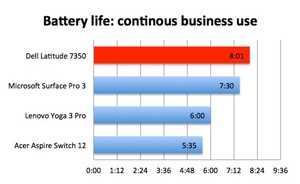
According to our first test, the Dell Latitude 7350 will last for an excellent eight hours when continuously used for typical office tasks. Since a typical day at the office also includes at least one (lunch) break and some idle time, we expect the Latitude 7350 to last for a whopping 10 hours straight without the need for an external power source. That's more than enough to keep you busy preparing for an important business meeting during a long overseas flight.
Curious as we are, we also ran this battery test with just the tablet section. It was able to last for five hours and 50 minutes when continuously used for office-related tasks. When taking some idle time into account as well, the tablet should autonomously be able to function for about 7.5 hours.
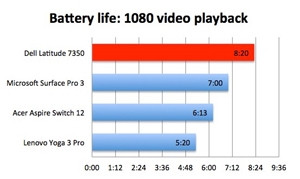
The second test also showed great test results from the Dell Latitude 7350. We were able to watch almost 8.5 hours of full-HD video material. Like with the first test, this is the highest battery score of all convertibles we included in this review. Without the secondary battery of the keyboard, the tablet alone can only show videos for five hours though.
In case of an empty battery, it is imperative to get it fully charged as soon as possible. After all, time equals money. To that end, Dell included ExpressCharge technology with the Latitude 7350. Although, we didn't actually test this specific feature it should be able to fully charge an empty battery in two hours while the device is turned off.
Screen: very good, but needs some calibrating
The Latitude 7350 features a 13.3-inch touchscreen that boast a resolution of 1 920 x 1 080 pixels, resulting in a pixel density of 166ppi. This resolution not only looks excellent while using the device as a notebook, but also when holding it closer in tablet mode.
We used our SpectraCal C6 colorimeter to measure the screen's brightness, contrast and colour reproduction. According to the colorimeter the maximum brightness level of the Latitude 7350's screen measures around 370cd/m^2. That's pretty high, but not enough to comfortably work with the device in direct sunlight. Business users who plan to use their device in light-intensive environments are better off with the Acer Aspire Switch 12 convertible (410cd/m^2). Contrast values, on the other hand, are top of the bill and in line with what you might expect from a high-end convertible with a matching price tag. As a result, colours are vivid and look gorgeous on the Latitude 7350's screen.
Accurate reproduction of these colours, important to business users that plan to do semi-serious image editing, leaves some to be desired. Luckily, there are ways to manually calibrate the specific colour temperature so they better represent reality. Viewing angles of the Latitude 7350 are very luxurious, meaning you don't need to look straight at the screen to see what's going on.
Verdict
Dell has been known to produce some great business notebooks and apparently also found a way to duplicate that winning formula to convertibles. The Latitude 7350 is far from cheap, but features a solid, mostly metal exterior as well as great battery life. It performs more than adequate for typical business users and offers an excellent screen.
The device has two serious drawbacks though, one being its total weight of 1.66kg. This is something business users should definitely take into consideration when they plan to carry the Latitude 7350 everywhere they go. The second drawback is that for the serious cash the device will cost you, the amount of RAM and storage space is quite scanty and will quickly prove insufficient for demanding business users.
Share